More and more young people are getting themselves inked, but what’s it like being at the other end of the needle? We spoke to Physical Graffiti’s Chris Jones about his life as a tattoo artist.
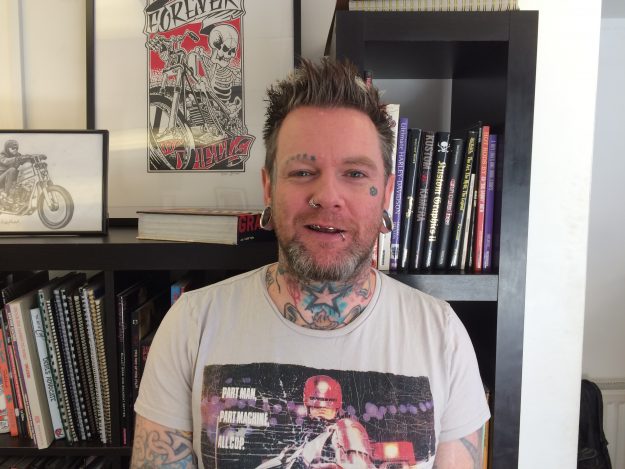
Climbing the stairs to his office and getting to work preparing his equipment, it’s obvious that Chris Jones’ lives by his profession. Co-owner and head artist at City Road’s Physical Graffiti studio, most of his body is covered in a variety of tattoos, along with piercings in the ears, nose and lip.
“I didn’t always want to be a tattooist,” Chris tells me as he takes a seat. “I think I wanted to be a graphic designer. I’d always had an interest in tattoos, I just thought, ‘you’ve got to be really good at art to do a tattoo on someone because it’s permanent, you can’t make a mistake, can’t rub it out’.” If Jones initially lacked confidence in his ability, there’s no sign of that today. Clearly in his element, Chris exudes an air of self-assurance as he readies his inks for the task at hand, involving adding Bruce Willis to a Pulp Fiction piece already including Samuel L. Jackson and John Travolta.
.embed-container { position: relative; padding-bottom: 56.25%; height: 0; overflow: hidden; max-width: 100%; } .embed-container iframe, .embed-container object, .embed-container embed { position: absolute; top: 0; left: 0; width: 100%; height: 100%; }
The love of cult movies is one Chris shares with his client, with memorabilia from comic books, fantasy films and primarily the Star Wars series adorning the walls and shelves of his loft studio. Against one wall a television stands opposite comfy leather sofas, surrounded by hundreds of Blu-rays. Standing proudly to one side are a collection of Comic-Con “Best tattoo” awards for his exploits at various American expos over the years.
Chris’ career in the industry began after getting tattooed as a teenager, and within twelve months he’d begun experimenting with doing them himself.
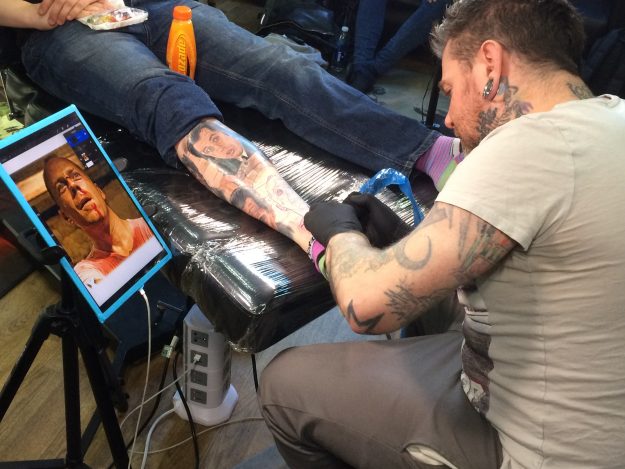
Having progressed over his career to the extent that he almost exclusively does portraits, the route to the peak is markedly different from most professions, with formal training programmes non-existent. “No such thing. You either get an apprenticeship or teach yourself. Teaching yourself nowadays is massively frowned upon and always has been by the industry, because nobody wants anyone else doing it. But there’s a lot more people that do it [teach themselves] these days because it’s easier to get hold of tattoo equipment.”
“It was a lot harder to get into back when I started tattooing. So people who got into it back then were only the people who really, really wanted to do it. Whereas nowadays it’s so easy to do, which is why there are so many bad tattoo artists out there!” Chris laughs but there’s also a hint in his voice that these ‘bad artists’ can grind his gears.
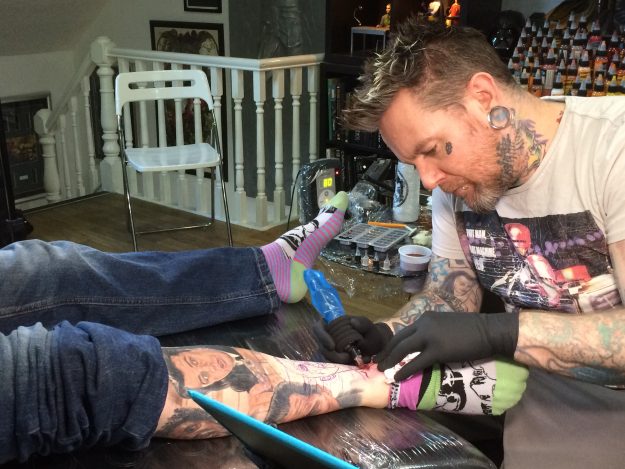
Having set the studio up in 2006 with co-founder Chris Hatton, Jones tells me that it was a relatively painless process, and that business has never really posed them a problem since. When I ask how it compares to someone working an office job, Chris’ response is immediate. “Their life sucks! Because basically I get to come in, tattoo cool stuff on cool people and basically sit and watch TV all day. I have worked; I’ve had an endless string of shitty jobs. I’ve worked in a call centre, so I fully appreciate what I do and how lucky I am. But I could never go back.”
As he sets to work on his hyper-detailed Willis, it’s clear from neighbouring tattoos on his client’s leg that Jones is an expert in his craft. You’d be forgiven for thinking you were looking at an oil painting.
.embed-container { position: relative; padding-bottom: 56.25%; height: 0; overflow: hidden; max-width: 100%; } .embed-container iframe, .embed-container object, .embed-container embed { position: absolute; top: 0; left: 0; width: 100%; height: 100%; }
While Chris personally only takes on portraits these days, he still notices trends elsewhere around the shop, viewing some of them with a certain disdain. “’Oriental’ has always been there. Then you get your “footballer tattoos”, where it was a kind of religious theme with clouds and angels and that’s slowly progressed into f*cking pocket watches and roses and other time pieces. And they’ve always got to have the time that their kid was born on them and stuff. I’m lucky enough and busy enough to be able to pick and choose what I want to do.”
An older one from @EpicInkJonesy back when he was in America last year pic.twitter.com/9uTI8fmqiM
— Physical Graffiti (@pgctcardiff) January 14, 2016
With regards to weird and whacky tats, Chris has seen so many he struggles to pick out individuals. “I’ve done camels on toes, bees on knees. Nothing really shocks me anymore, that’s the thing. ‘Here we go again’. Women’s vaginas and men’s bums, nothing really stands out.”
That’s not to say there haven’t been designs that have affected the type of client walking into Physical Graffiti. “I did a set of nipples on a woman that had breast cancer and had prosthetic breasts which didn’t have nipples. I’ve done so many nipples since then. Apparently the registrar now tells women that need it done that they can get it on NHS for free (but it’s not very good), but you need to check out Chris Jones in Cardiff.”
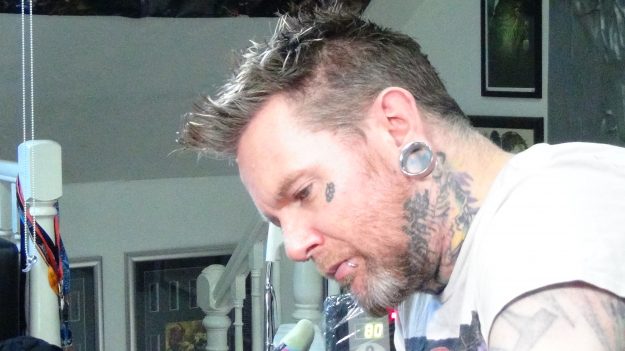
Otherwise Chris tries to keep himself detached from the stories behind tattoos given past experiences. “There’s times I’ve put my foot in it and asked for other photos of a child because the photos aren’t very good, and they say “the kid’s dead, we can’t give you any more photos.””
In the wider world there is still a stigma around tattoos in certain lines of work, but it’s a problem which Chris sees evolving rather than ever truly disappearing. “Maybe in my lifetime as the younger generation becomes the older generation. But because it’ll be the norm, the (new) younger generation will be looking to do something that’s more shocking, that isn’t socially acceptable, because that’s what young people do. The more tattooing becomes socially acceptable, the more people will get them done like, on their face or their eyeballs, because people just want to shock.”
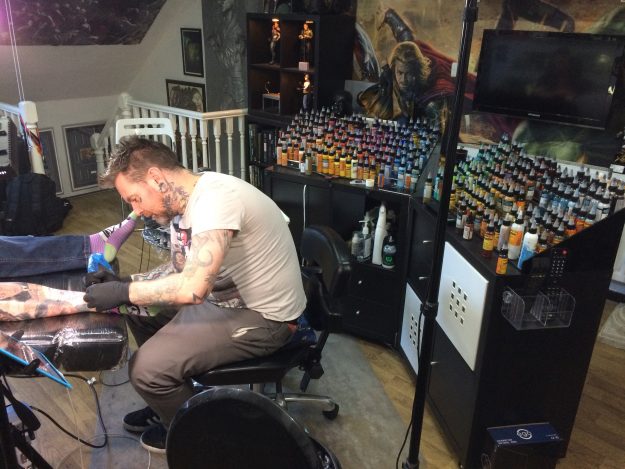
Jones is critical of ‘Tattoo TV’ such as E4’s Tattoo Fixers despite having taken part in a show himself, filming ten episodes of ‘Epic Ink’ in the USA. “I didn’t wanna go on TV, I just wanted to go spend two months in America with my friends, doing cool stuff.” Unlike some of the artists on Fixers, Chris believes he maintained his working integrity while filming “I kicked off quite a lot, told them to leave me the f*ck alone and let me do what I need to do. At the end of the day what I’m doing is quite important, and I can’t be doing with interruptions.”
Having finished his preliminary set-up, as the two of us wait for his client to arrive so the 7-hour undertaking can begin, Chris reflects upon his brush with the kind of celebrity shouldered by the guys on ‘Fixers. “It was hard work, we were working sixteen hour days. But we had a fun crew, it was a good experience.” Jones looks up from his work and smiles, “But again, I don’t wanna be famous, I just wanna do cool tattoos.”
